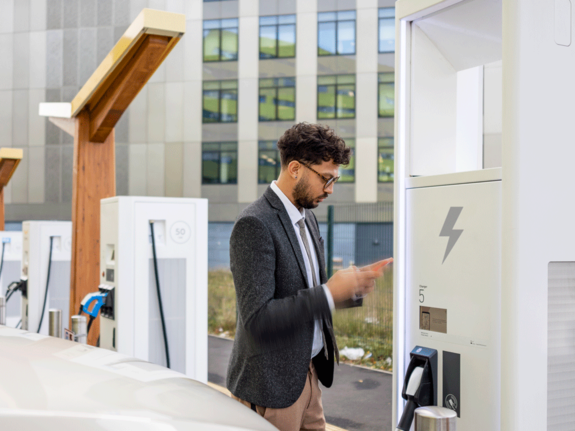The future of transport is electric
An electrified fleet is made up of electric vehicles (EVs) or zero-emissions vehicles (ZEVs). Driving an EV is more energy-efficient than a gas-powered car, because EVs are more efficient at converting electricity into forward motion. However, there are some drawbacks: EVs have high upfront costs, diminished battery performance in cold weather, and negative social and environmental impacts from the resource extraction required to make batteries.
On average, SMEs that electrified their vehicle fleet took 21 months to recoup their investment.
Roadmap to electrifying your fleet
Study your current vehicle use to help you switch to an EV fleet. Electric vehicles have different refuelling and maintenance needs than fossil fuel-powered vehicles. This means you may need to adapt your current driving routes, refuelling times and overhead cost projections to ensure a smooth transition when your EVs hit the road.
Search for opportunities to optimize your current energy use by altering your routes or redeploying vehicles. Then, with the help of research, make a list of EVs and types of charging stations that best suit your needs.
-
Electric vehicle chargers: the basics
Discover a variety of information about electric vehicle charging at home and the benefits for your business.
For some companies, a successful transition to an EV fleet may simply mean making the switch from fossil fuel- to electricity-powered vehicles. Others might define “success” by a certain amount of money saved on fuel and maintenance. Deciding how you will quantify success will help you track your progress and bring your staff along on the journey.
-
Natural Resources Canada: 2025 Fuel Consumption Guide
Compare the fuel consumption of your vehicles with this guide.
-
BC Hydro fleet electrification guide
Learn about BCH hydro's resources and incentives to electrify your fleet of vehicles.
There are many government incentives designed to encourage businesses and consumers to buy EVs, but as we start to see more and more EVs rolling on streets, government incentives may dry up. Canada has banned in 2021 the sale of fuel-burning new cars and light-duty trucks from 2035. Getting started on your fleet electrification plan now will allow you to take advantage of rebates before they are phased out.
-
List of EV charging incentive programs, equipment manufacturers and electric contractor associations across Canada
Discover BDC's guide on workplace charging in Canada.
-
Incentives for purchasing zero-emission vehicles
Learn about the federal government's incentive program to make the higher upfront purchase cost of zero-emission vehicles more affordable.
-
Tax write-off for zero-emission vehicles
Learn about the Incentives for Zero-Emission Vehicles (iZEV) Program which aims to make zero-emissions vehicles more affordable.
Consider installing more chargers than are immediately necessary when you buy your first EV. This will save you recurring installation costs as your EV fleet grows. Also, decide who will have access to your chargers. Your employees for their personal cars? Your customers? What about business visitors?
Finally, remember that EV ranges diminish over time. Having a fleet management plan that accounts for older EVs by assigning them to shorter routes will help you get the most out of your fleet. Consider as well what you’ll do when cold weather diminishes the battery performance and lowers the driving range—an unavoidable reality in Canadian winters.
-
Zero Emission Vehicle Infrastructure Program
Learn about the Zero Emission Vehicle Infrastructure Program, which provides funding towards the deployment of electric vehicle chargers and hydrogen refuelling stations across Canada.
Recommended resources

Discover over 60 green governmental active grants, tax credits and loan programs.

Reducing your GHG emissions is a smart move for both your business and the planet. Discover the key areas in your business where you can take action now.
Discover our solutions
The content of this webpage is provided for information purposes only, and the reader is responsible for any decisions resulting from its use. The results of applying the content are not guaranteed by BDC and may vary depending on the context, market, sector, financial situation and size of the company. Content originating from a source outside of BDC is the sole responsibility of the author of that source.



